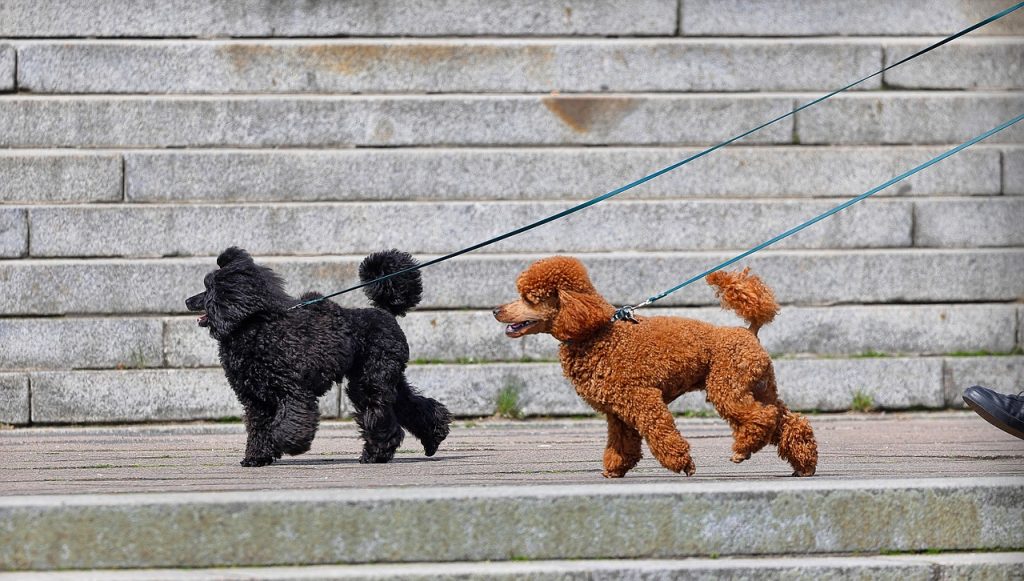Introduction: Why Training Your Poodle is Essential
Poodles are widely known for their intelligence, which makes them one of the most trainable dog breeds. However, their high energy levels, curiosity, and sometimes stubborn nature require an approach tailored to their unique personalities. Proper training not only ensures your poodle is well-behaved and socialized but also enhances your bond with your dog and helps them adapt to various environments and situations.
In this article, we will explore various training techniques, tips, and methods specifically suited to poodles, from basic obedience commands to advanced behavioral training. Whether you’re a new poodle owner or have experience with dogs, this guide will help you understand the best ways to train your poodle and nurture their full potential.
I. Understanding the Poodle’s Intelligence and Training Needs
A. Why Poodles Are So Trainable
- The High Intelligence of Poodles: Discuss how poodles rank among the most intelligent dog breeds, and how this impacts their ability to learn new skills and commands quickly.
- Poodle Temperament: Highlight their eagerness to please, which can make them responsive to training, but also their sensitivity to harsh training methods.
B. The Importance of Positive Reinforcement
- What is Positive Reinforcement?: Explain the concept of rewarding desired behaviors (treats, praise, toys) to encourage repetition.
- Why Positive Reinforcement Works for Poodles: Poodles tend to respond best to kindness and patience, as they are sensitive and can become discouraged with harsh training methods.
C. Understanding the Poodle’s Energy Levels
- High Energy and Focus: Talk about how poodles need both physical and mental stimulation. If they don’t get enough exercise or stimulation, they may act out.
- Training for Focus: Incorporate exercises to improve attention span, like training sessions in quiet environments to minimize distractions.
II. Basic Obedience Training for Poodles
A. Sit, Stay, and Come: The Foundation of Obedience
- Teaching “Sit”: Explain the step-by-step process of teaching “sit,” starting with luring the poodle into position with a treat and using praise when they comply.
- Teaching “Stay”: Building on “sit,” teach your poodle to remain in place even when you step away, using gradual increments of distance and time.
- Teaching “Come”: The recall command is essential for poodle safety. Discuss how to practice with a leash or long line and then move to off-leash recall.
B. Heel: Walking on a Leash Without Pulling
- The Right Equipment: Recommend suitable collars or harnesses and leashes for leash training.
- Techniques to Avoid Pulling: Teach loose-leash walking with methods like the “stop-and-go” technique and rewarding the poodle for staying by your side.
C. Potty Training and Crate Training
- Potty Training: Discuss how to establish a regular routine for potty breaks, recognizing signals, and using crate training to encourage housebreaking.
- Crate Training: Explain how to make the crate a positive place, providing treats and toys for comfort, and avoiding using the crate as punishment.
III. Socialization and Behavioral Training for Poodles
A. Importance of Socializing Your Poodle
- Why Socialization is Crucial: Talk about the importance of exposing your poodle to different environments, people, and animals early to prevent anxiety and fear-based behaviors.
- Positive Socialization Methods: Encourage controlled introductions to new experiences, rewarding calm behavior, and gradually increasing exposure.
B. Handling Separation Anxiety
- Signs of Separation Anxiety in Poodles: Discuss behaviors like excessive barking, destructive chewing, and accidents when left alone.
- Training to Alleviate Anxiety: Use crate training, gradual departures, and mental stimulation to ease your poodle’s anxiety.
C. Correcting Unwanted Behaviors
- Excessive Barking: Teach your poodle to understand when barking is acceptable and when it’s not, using techniques like the “quiet” command or distraction methods.
- Jumping on People: Address this behavior by teaching the poodle to greet people calmly, rewarding them when their paws stay on the ground.
- Destructive Chewing: Provide appropriate chew toys, and use methods to redirect attention away from household items.

IV. Advanced Training Techniques for Poodles
A. Trick Training and Mental Stimulation
- Learning Fun Tricks: Once basic obedience is established, teach your poodle fun tricks like “roll over,” “shake,” and “play dead” using the same positive reinforcement techniques.
- Puzzle Toys and Brain Games: Incorporate puzzle toys to challenge your poodle mentally and prevent boredom.
B. Agility Training for Poodles
- Introduction to Agility: Explain how poodles excel in agility training due to their intelligence and athleticism.
- Basic Agility Equipment: Introduce beginner obstacles like tunnels, jumps, and weave poles.
- Training Agility Skills: Step-by-step guidance on training your poodle to navigate an agility course, starting with one obstacle at a time and gradually increasing difficulty.
C. Teaching Off-Leash Skills
- Building Trust for Off-Leash Training: Start with a long leash or a fenced area and progress to off-leash training in a safe environment.
- Consistency is Key: Emphasize the importance of consistent reinforcement, especially when transitioning from leash to off-leash obedience.
V. Training Techniques for Specific Poodle Types
A. Training Standard Poodles
- Why They May Require More Mental Stimulation: Standard poodles are larger and more active, often requiring more exercise and complex training.
- Strengths and Challenges in Training: Address their natural intelligence and potential stubbornness, suggesting techniques for keeping training sessions engaging.
B. Training Miniature Poodles
- Handling Smaller Size and Energy: Miniature poodles may have less physical space to burn off energy, so more frequent mental stimulation and short, frequent training sessions are important.
- Building Focus with Short Training Sessions: Miniature poodles can sometimes be more distracted, so keeping training sessions shorter but more frequent helps with their attention span.
C. Training Toy Poodles
- Addressing Fragility and Temperament: Toy poodles require a gentler approach, as they may be more sensitive and prone to anxiety.
- Socialization Needs for Toy Poodles: These smaller poodles need socialization just as much, especially since their small size can sometimes lead to nervousness in new situations.
VI. Understanding and Managing Poodle Behavior Issues
A. Understanding Poodle Behavior
- Why Poodles Might Misbehave: Examine how boredom, lack of exercise, or inadequate training can lead to unwanted behaviors.
- Addressing Negative Behavior with Positive Solutions: Discuss using redirection techniques, interactive toys, and mental challenges to counteract behaviors like barking or chewing.
B. The Role of Consistency and Routine
- Setting a Training Schedule: Establishing a consistent training routine, including regular practice sessions and reward-based reinforcement.
- The Power of Patience: Encouraging owners to be patient, as poodles, though highly intelligent, may take time to master complex tasks.
C. Overcoming Stubbornness in Poodles
- Why Some Poodles Are Stubborn: Discuss how poodles may become independent thinkers as they mature, which can lead to reluctance in training.
- Keeping Training Fun: Use positive reinforcements, play, and variation in training techniques to maintain interest and motivation.
VII. The Role of Professional Training and Classes
A. When to Seek Professional Help
- Identifying the Right Time for a Professional Trainer: If training has become frustrating or your poodle is exhibiting behavior issues beyond your control, it may be time to enlist the help of a professional trainer.
- Choosing the Right Trainer: Consider certifications, experience, and training philosophy to find the right professional for your poodle.
B. Group Classes vs. Private Lessons
- Group Obedience Classes: Benefits of group classes, including socialization with other dogs and controlled distractions.
- Private Lessons: When private lessons may be more appropriate for individualized attention, especially for specific behavior concerns.
VIII. Conclusion: The Lifelong Journey of Poodle Training
Training a poodle is not a one-time task but a lifelong journey. By establishing a strong foundation of basic obedience and gradually moving on to more advanced skills, you can ensure that your poodle becomes a well-behaved, happy companion. Remember, consistency, patience, and positive reinforcement are key to success.
Whether you’re teaching basic commands, advanced tricks, or working through behavioral issues, the bond you build with your poodle during the training process will enrich both your lives. With the right approach, your poodle can grow into a well-adjusted, confident, and obedient dog who is a joy to live with.























































